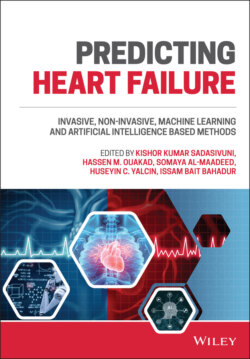Читать книгу Predicting Heart Failure - Группа авторов - Страница 76
2.5.1 AI in Echocardiography
ОглавлениеThe role of ultrasound devices is vital in the early diagnosis of cardiovascular diseases (CVDs). In addition, some of the risk factors of CVDs can be due to high blood pressure or high cholesterol, and one of the main causes of such diseases can be the buildup of inflammatory cells known as plaques, which occur in the arterial wall and result in both blood restriction to the heart and lower oxygen intake. This medical condition is known as atherosclerosis. Early prediction of a CVD disease might help in preventing the progression of atherosclerosis as well as possible heart failures. In Figure 2.8, it is shown that plaque formation occurs mostly in the common carotid artery and internal carotid artery.
Figure 2.8 Formation of plaques in the common carotid artery and internal carotid artery.
One of the ways to identify the plaques in the arterial wall is by analyzing the carotid artery, which consists of a pair of blood vessels and has several parts, namely internal, external, and common parts. Plaques occur in the internal section as well as in the common blood vessels of the carotid artery. Hence, plaques create a thicker wall in these vessels, and can be measured as intima-media thickness (IMT). Thus, carotid IMT is used as a risk marker for early heart disease prediction. It can be done by measuring the difference between the lumen-intima (LI) and media adventitia (MA) walls [23].
Recently, many applications regarding ultrasound image segmentation using machine learning and deep learning techniques have been implemented to detect atherosclerosis. The work proposed in Nagaraj [24] used support vector machines (SVM) to train and segment IMT using a dataset of 49 images and resulted in 93% accuracy. Other researchers (see Biswas, Saba, et al. [25]) have worked on a screening tool that integrates a two-stage AI model for IMT and carotid plaque measurements, and consists of a convolutional neural network (CNN) and a fully convolutional network (FCN). The system goes through two deep learning models. The first divides the common carotid artery from the ultrasound images into two categories: the rectangular wall and non-wall patches. Then, the region of interest is analyzed and fed to the second stage, which identifies features in order to calculate the carotid IMT and the plaque total.
The work in Biswas, Kuppili, et al. [26] combined both the CNN algorithm and the machine learning based regression technique for IMT segmentation. Further, Menchón-Lara and colleagues [27] implemented an autoencoder model for segmenting IMT. Their method included regions of interest (ROI) prediction and then LI interface (LII) and MA interface (MAI) walls predictions in the predicted ROI. The authors reported that they used extreme learning machines along with autoencoders to distinguish between the block included in the ROI and the excluded from the ROI. The LII and MAI recognition was done using pixel classification.
